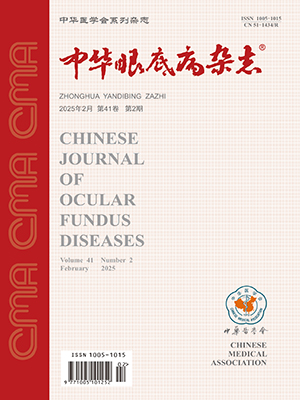| 1. |
Eckardt C, Eckardt U, Groos S, et al. Removal of the internal limiting membrane in macular holes: clinical and morphological findings[J]. Ophthalmologe, 1997, 94(8): 545-551. DOI: 10.1007/s003470050156.
|
| 2. |
Lois N, Burr J, Norrie J, et al. Internal limiting membrane peeling versus no peeling for idiopathic full-thickness macular hole: a pragmatic randomized controlled trial[J]. Invest Ophthalmol Vis Sci, 2011, 52(3): 1586-1592. DOI: 10.1167/iovs.10-6287.
|
| 3. |
Kim K, Kim ES, Kim Y, et al. Correlation between preoperative en face optical coherence tomography of photoreceptor layer and visual prognosis after macular hole surgery[J]. Retina, 2018, 38(6): 1220-1230. DOI: 10.1097/IAE.0000000000001679.
|
| 4. |
Michalewska Z, Michalewski J, Cisiecki S, et al. Correlation between foveal structure and visual outcome following macular hole surgery: a spectral optical coherence tomography study[J]. Graefe's Arch Clin Exp Ophthalmol, 2008, 246(6): 823-830. DOI: 10.1007/s00417-007-0764-5.
|
| 5. |
Gass JD. Idiopathic senile macular hole: its early stages and pathogenesis[J]. Arch Ophthalmol, 1988, 106(5): 629. DOI: 10.1001/archopht.1988.01060130683026.
|
| 6. |
Kang SW, Ahn K, Ham DI. Types of macular hole closure and their clinical implications[J]. Br J Ophthalmol, 2003, 87(8): 1015-1019. DOI: 10.1136/bjo.87.8.1015.
|
| 7. |
Inoue M, Watanabe Y, Arakawa A, et al. Spectral-domain optical coherence tomography images of inner/outer segment junctions and macular hole surgery outcomes[J]. Graefe's Arch Clin Exp Ophthalmol, 2009, 247(3): 325-330. DOI: 10.1007/s00417-008-0999-9.
|
| 8. |
Baba T, Yamamoto S, Arai M, et al. Correlation of visual recovery and presence of photoreceptor inner/outer segment junction in optical coherence images after successful macular hole repair[J]. Retina, 2008, 28(3): 453-458. DOI: 10.1097/IAE.0b013e3181571398.
|
| 9. |
Haritoglou C, Neubauer AS, Reiniger IW, et al. Long-term functional outcome of macular hole surgery correlated to optical coherence tomography measurements[J]. Clin Exp Ophthalmol, 2007, 35(3): 208-213. DOI: 10.1111/j.1442-9071.2006.01445.x.
|
| 10. |
Michalewska Z, Michalewski J, Adelman RA, et al. Inverted internal limiting membrane flap technique for large macular holes[J]. Ophthalmology, 2010, 117(10): 2018-2025. DOI: 10.1016/j.ophtha.2010.02.011.
|
| 11. |
Michalewska Z, Michalewski J, Dulczewska-Cichecka K, et al. Inverted internal limiting membrane flap technique for surgical repair of myopic macular holes[J]. Retina, 2014, 34(4): 664-669. DOI: 10.1097/IAE.0000000000000042.
|
| 12. |
Byhr E, Lindblom B. Preoperative measurements of macular hole with scanning laser ophthalmoscopy[J]. Acta Ophthalmol Scand, 1998, 76(5): 579-583. DOI: 10.1034/j.1600-0420.1998.760513.x.
|
| 13. |
Amari F, Ohta K, Kojima H, et al. Predicting visual outcome after macular hole surgery using scanning laser ophthalmoscope microperimetry[J]. Br J Ophthalmol, 2001, 85(1): 96-98. DOI: 10.1136/bjo.85.1.96.
|
| 14. |
Ullrich S, Haritoglou C, Gass C, et al. Macular hole size as a prognostic factor in macular hole surgery[J]. Br J Ophthalmol, 2002, 86(4): 390-393. DOI: 10.1136/bjo.86.4.390.
|
| 15. |
Kusuhara S, Teraoka Escaño MF, Fujii S, et al. Prediction of postoperative visual outcome based on hole configuration by optical coherence tomography in eyes with idiopathic macular holes[J]. Am J Ophthalmol, 2004, 138(5): 709-716. DOI: 10.1016/j.ajo.2004.04.063.
|
| 16. |
Kaźmierczak K, Stafiej J, Stachura J, et al. Long-term anatomic and functional outcomes after macular hole surgery[J/OL]. J Ophthalmol, 2018, 2018: 3082194[2018-11-26]. https://doi.org/10.1155/2018/3082194. DOI: 10.1155/2018/3082194.
|
| 17. |
Staurenghi G, Sadda S, Chakravarthy U, et al. Proposed lexicon for anatomic landmarks in normal posterior segment spectral-domain optical coherence tomography: the IN•OCT consensus[J]. Ophthalmology, 2014, 121(8): 1572-1578. DOI: 10.1016/j.ophtha.2014.02.023.
|
| 18. |
Ruiz-Moreno JM, Lugo F, Montero JA, et al. Restoration of macular structure as the determining factor for macular hole surgery outcome[J]. Graefe's Arch Clin Exp Ophthalmol, 2012, 250(10): 1409-1414. DOI: 10.1007/s00417-012-1963-2.
|
| 19. |
Mitamura Y, Mitamura-Aizawa S, Katome T, et al. Photoreceptor impairment and restoration on optical coherence tomographic image[J/OL]. J Ophthalmol, 2013, 2013: 518170[2013-04-03]. https://doi.org/10.1155/2013/518170. DOI: 10.1155/2013/518170.
|
| 20. |
Oh J, Yang SM, Choi YM, et al. Glial proliferation after vitrectomy for a macular hole: a spectral domain optical coherence tomography study[J]. Graefe's Arch Clin Exp Ophthalmol, 2013, 251(2): 477-484. DOI: 10.1007/s00417-012-2058-9.
|




